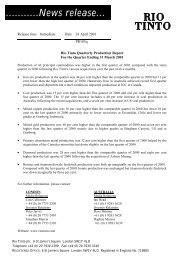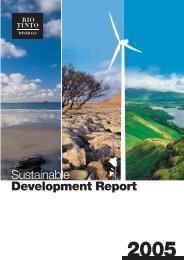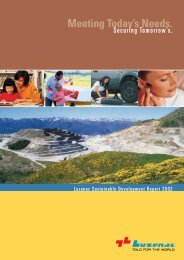HIsmelt Sustainable Development Report 2007 - Rio Tinto
HIsmelt Sustainable Development Report 2007 - Rio Tinto
HIsmelt Sustainable Development Report 2007 - Rio Tinto
Create successful ePaper yourself
Turn your PDF publications into a flip-book with our unique Google optimized e-Paper software.
<strong>HIsmelt</strong> <strong>Sustainable</strong><br />
<strong>Development</strong> <strong>Report</strong><br />
<strong>2007</strong>
The <strong>HIsmelt</strong> process is the most<br />
important advance in iron making<br />
technology since the Chinese<br />
invented the blast furnace 2,000<br />
years ago.<br />
The first <strong>HIsmelt</strong> facility in the<br />
world based in Kwinana, Western<br />
Australia is setting the highest<br />
environmental standards.<br />
Front cover;<br />
The <strong>HIsmelt</strong> facility is located on<br />
Cockburn Sound, an inlet of the<br />
Indian Ocean used regularly to<br />
train horses.<br />
Contents<br />
02 MD’s Message<br />
04 <strong>Sustainable</strong> <strong>Development</strong><br />
06 People<br />
14 Planet<br />
19 Prosperity
MD’s Message<br />
We have found a better way<br />
We have found a<br />
better way.<br />
It’s a challenge the whole world is talking<br />
about. How do we continue to advance<br />
societies through economic development<br />
while taking special care to protect the<br />
environment?<br />
For <strong>HIsmelt</strong>, this rests with a technology<br />
we have developed over 25 years to bring<br />
to market a better environmental solution<br />
to iron and steel production.<br />
In 2006, our world first <strong>HIsmelt</strong>® plant<br />
located in Kwinana, Western Australia<br />
began producing, on a commercial scale,<br />
a premium grade iron product called pig<br />
iron. Pig iron is a primary ingredient in<br />
steel making.<br />
We have proven to the world that there<br />
is a better way to produce iron and steel<br />
with a significantly lower environmental<br />
footprint.<br />
Environmental advantage is just one way we contribute<br />
to sustainable development. We also recognise the<br />
importance of our social contribution. The health and<br />
safety of our employees and communities comes before<br />
everything else. We also work with the community to<br />
support projects and initiatives that bring about positive<br />
experiences for local people. While all our partnerships are<br />
important to us we place particular emphasis on building<br />
future workforce capability for young people in the area.<br />
This report summarises our <strong>2007</strong> performance across<br />
social, environmental and economic dimensions – we refer<br />
to these as People, Planet and Prosperity.<br />
I would like to thank all <strong>HIsmelt</strong> employees and<br />
contractors for their efforts during <strong>2007</strong>. It’s a big ask<br />
to transform a research and development project into a<br />
fully operational facility. While we are not without our<br />
challenges, we have a focused and committed team that is<br />
working hard to achieve our operational and sustainable<br />
development goals.<br />
We welcome your feedback on this report by emailing us at<br />
mail@hismelt.riotinto.com.au.<br />
Stephan Weber<br />
Managing Director, <strong>HIsmelt</strong><br />
02 03<br />
MD’s Message<br />
We have found a better way
<strong>Sustainable</strong> <strong>Development</strong><br />
What does it mean to <strong>HIsmelt</strong>?<br />
Global demand for iron and steel<br />
continues to grow, just as expectations<br />
by society to produce these products in a<br />
socially and environmentally responsible<br />
way are at an all time high.<br />
<strong>HIsmelt</strong> is delivering better environmental<br />
solutions to the ironmaking industry, and<br />
in doing so hopes to assist developed and<br />
developing countries to meet their own<br />
sustainable development (SD) goals.<br />
<strong>HIsmelt</strong>’s commitment to SD is reflected in the way we<br />
work and what we do everyday. It is not only the right<br />
thing to do but makes good business sense.<br />
We ensure that our contributions to sustainable<br />
development are both tangible and meaningful through<br />
activities in the following six areas:<br />
• Environment<br />
• Communities<br />
• Materials stewardship<br />
• Employees<br />
• Operations<br />
• Business partners.<br />
We publicly report our social, environmental and<br />
economic contribution each year in this, our <strong>Sustainable</strong><br />
<strong>Development</strong> <strong>Report</strong>. We do this under three key themes<br />
- People, Planet and Prosperity.<br />
To be successful, sustainable development (SD) should be<br />
integrated into all aspects of what we do. To achieve this<br />
we have developed a SD framework that articulates our key<br />
focus areas, key stakeholders and key initiatives each year.<br />
The framework allows us to focus our efforts and track<br />
progress on each key area. In 2008 formal performance<br />
indicators will be established against the six areas of SD.<br />
EnvironmEnt<br />
opErations stEwardship<br />
partnErs Community<br />
EmployEEs<br />
<strong>HIsmelt</strong> Community Advisory Committee on <strong>Sustainable</strong><br />
<strong>Development</strong><br />
The local community plays a key role in <strong>HIsmelt</strong>’s<br />
sustainable development program. A 10-member<br />
Community Advisory Group operates as a direct link<br />
between the company and our community, helping to<br />
assess local issues and investigating new ways to promote<br />
sustainable development with internal and external<br />
stakeholders.<br />
The voluntary advisors, along with members of <strong>HIsmelt</strong>’s<br />
management team and operations staff, develop a detailed<br />
understanding of our business and work to:<br />
• Identify local programs of benefit to <strong>HIsmelt</strong> and the<br />
community.<br />
• Participate in community surveys to determine local<br />
needs.<br />
• Contribute and investigate new ideas to promote SD<br />
initiatives.<br />
• Inform the community about sustainable development<br />
activities at <strong>HIsmelt</strong>.<br />
<strong>Sustainable</strong> <strong>Development</strong> <strong>2007</strong> Performance Summary<br />
Focus Area Measure Result Comment<br />
People • Total lost time injuries<br />
• Medical treatment cases<br />
• Intake of graduates,<br />
trainees and apprentices<br />
intake<br />
• Community partnerships<br />
Planet • Greenhouse gas emissions<br />
intensity<br />
• Treated waste water<br />
(KWRP)<br />
• Scheme water<br />
• Environmental incidents<br />
Prosperity • Tonnes of pig iron produced<br />
• Material stewardship<br />
– life cycle assessment<br />
of <strong>HIsmelt</strong> operation<br />
commenced<br />
04 05<br />
2<br />
3<br />
Employed a total of 6 trainees,<br />
graduates and apprentices<br />
4 major partnerships and<br />
a range of sponsorships in<br />
addition to wider <strong>Rio</strong> <strong>Tinto</strong><br />
Group spend locally<br />
-e 4.5tCO2 1267 ML<br />
571 ML<br />
No high or critical<br />
121,530 tonnes<br />
Assessment 80% complete<br />
Same number of injuries as<br />
2006<br />
Improved number of medical<br />
treatment cases from 2006<br />
Increased number from 2006<br />
Shift in focus from<br />
sponsorships to sustainable<br />
partnerships<br />
Significant improvement from<br />
2006<br />
Analysis of site water balance<br />
to reduce scheme water usage<br />
and maximise KWRP water<br />
usage<br />
6 minor incidents<br />
An increase in production from<br />
94,183 tonnes in 2006<br />
See Prosperity section of this<br />
report for further information<br />
<strong>Sustainable</strong> <strong>Development</strong><br />
What does it mean to <strong>HIsmelt</strong>?
People<br />
Working with the community 06<br />
We seek to understand the social,<br />
economic and environmental impacts and<br />
opportunities arising from our activities,<br />
for the local and wider community.<br />
Stakeholders are local communities,<br />
including Indigenous communities, in the<br />
Cockburn, Kwinana and Rockingham area;<br />
<strong>HIsmelt</strong> employees and contractors; non<br />
government interest groups; Federal, State<br />
and local governments including relevant<br />
agencies and departments; joint venture<br />
partners and suppliers.<br />
We adopt a philosophy of respect for all stakeholders and<br />
honour the needs of the local community by ensuring<br />
we listen, act and do what we say we will do. Noise is an<br />
example of an issue raised by community where we have<br />
taken direct action. In <strong>2007</strong> we began monitoring noise<br />
levels on a daily basis and reporting results publicly on the<br />
<strong>HIsmelt</strong> internet site. This level of reporting is continuing.<br />
We continue to be a full member of the Kwinana Industries<br />
Council. This local business association with around 40<br />
full and associate industry members aims to promote and<br />
contribute to the sustainable co-existence of Kwinana<br />
industry, the community and the environment.<br />
Community consultation happens through various means.<br />
We attend the bi-monthly Community Industries Forum<br />
run by the Kwinana Industries Council. We regularly<br />
attend meetings in the local area at the request of<br />
community, government or industries. Feedback received<br />
at these forums that relate to <strong>HIsmelt</strong> are formally reported<br />
through to the <strong>HIsmelt</strong> senior management team. The<br />
team then considers any course of action to expand on an<br />
idea or opportunity or to mitigate or resolve an issue.<br />
The <strong>HIsmelt</strong> Community Advisory Committee on<br />
<strong>Sustainable</strong> <strong>Development</strong> helps to guide and inform<br />
us on future community partnerships and sustainable<br />
development initiatives. Please refer to the <strong>Sustainable</strong><br />
<strong>Development</strong> at <strong>HIsmelt</strong> section of this report.<br />
In <strong>2007</strong>, <strong>Rio</strong> <strong>Tinto</strong> conducted two surveys – Opinion<br />
Leader Research and a General Public Reputation Study<br />
which included the <strong>HIsmelt</strong> Operations in Kwinana.<br />
<strong>Rio</strong> <strong>Tinto</strong>’s economic contributions to and investments in<br />
the region were recognised as high. Issues for the future<br />
revolved mainly around environmental concerns, including:<br />
• Protection of flora and fauna impacted by operations.<br />
• Responsible water and energy use.<br />
• Being involved in environmental programs.<br />
Comments on what <strong>Rio</strong> <strong>Tinto</strong> is doing well included:<br />
“Recognising the rights of Indigenous Western Australians<br />
and working to ensure those rights are factored into the<br />
company’s business policies and procedures.”<br />
“An effective and efficient mining company that provides<br />
leadership on a number of issues both economic and social.”<br />
“They’re providing<br />
employment and jobs,<br />
which is good for the<br />
Australian economy.”<br />
Comments on what <strong>Rio</strong> <strong>Tinto</strong> could do better:<br />
“Working more closely with government agencies to<br />
provide infrastructure and services to the company’s<br />
communities, particularly during the boom years.”<br />
“Measuring social impacts, not just applying<br />
environmental assessment processes.”<br />
“Trying to run things better so as not to damage the<br />
environment – regulate greenhouse emissions and the<br />
fuels they use.”<br />
<strong>HIsmelt</strong> is proud to<br />
support community<br />
and education programs.
“Open Days are a great way<br />
to meet our neighbours.”<br />
<strong>HIsmelt</strong> Community Open Day<br />
We opened our doors to the public in <strong>2007</strong> at the <strong>HIsmelt</strong><br />
Community Open Day. Over 400 local community<br />
members visited our operations, went on a site tour and<br />
learnt about how the <strong>HIsmelt</strong> technology is forging a<br />
new era in iron and steelmaking technology. Community<br />
partners manned displays at the event, profiling<br />
their achievements, projects and activities and a fun<br />
questionnaire tested people’s knowledge of <strong>HIsmelt</strong> and<br />
what we do. <strong>HIsmelt</strong> employees from all facets of the<br />
business gave up their own time to be at the event and<br />
answer questions.<br />
Community Partnerships<br />
At <strong>HIsmelt</strong> we invest in community development projects<br />
via long term partnerships designed to enhance quality of<br />
life through education, technology and the environment.<br />
Major community partnership and activities <strong>HIsmelt</strong> was<br />
involved in for <strong>2007</strong> include:<br />
Learning for Life<br />
Kwinana families are unlocking the reading potential<br />
of their children through an important local education<br />
partnership between <strong>Rio</strong> <strong>Tinto</strong> (including <strong>HIsmelt</strong>) and<br />
The Smith Family.<br />
First formed in July 2003, the partnership facilitates The<br />
Smith Family’s Learning for Life program in the Kwinana<br />
region. In the next three years <strong>Rio</strong> <strong>Tinto</strong>, through <strong>HIsmelt</strong><br />
and its community investment arm the <strong>Rio</strong> <strong>Tinto</strong> WA<br />
Future Fund, will contribute $780,000 to The Smith Family<br />
in support of this initiative.<br />
Learning for Life is a scholarship program that helps<br />
hundreds of Western Australian children gain access to<br />
education by providing financial support to assist with<br />
education costs such as books, uniforms, stationery,<br />
excursions and camps.<br />
In <strong>2007</strong>, a new innovative program as part of Learning for<br />
Life called Keys to Literacy was launched. The program<br />
unites a number of Kwinana community groups with<br />
literacy programs under one banner to provide a suite of<br />
resources for parents and children of all ages.<br />
Keys to Literacy includes the following programs:<br />
Better Beginnings is a universal early intervention family<br />
literacy program that focuses on working in partnership<br />
with families to provide positive language and literacy<br />
influences for children in their first three years of life.<br />
The program has been developed by the State Library of<br />
Western Australia in response to the early years research<br />
that shows that learning to read is the single most<br />
important factor in school success.<br />
Let’s Read is an early childhood literacy initiative of the<br />
Centre for Community Child Health (a key research<br />
centre of the Murdoch Children’s Research Institute) in<br />
partnership with The Smith Family, aiming to give families<br />
the information and tools they need to introduce their<br />
preschool-aged children (0-5 years) to books in a bid to<br />
improve Australia’s literacy levels.<br />
Kwinana Industries Education Partnership (KIEP)<br />
KIEP is a formal agreement between members of the<br />
Kwinana Industries Council and the 10 local senior high<br />
schools. The partnership aims to bring education closer to<br />
industry with the ultimate goal of switching youth on to<br />
seeking careers in the local region.<br />
Raising students’ awareness early on about the sorts of jobs<br />
that are on offer along the Kwinana strip gives companies<br />
in the region the best possible chance of securing a local<br />
future workforce.<br />
Working with the community 09<br />
People
Community Partnerships continued<br />
Baldja Lunch Program<br />
At a local primary school in Kwinana two dollars provides<br />
a healthy sandwich and drink for children who may<br />
otherwise go without lunch.<br />
A program run by the local Aboriginal enterprise, Baldja,<br />
and supported by <strong>HIsmelt</strong> in <strong>2007</strong>, provides around 300<br />
lunches each week, delivering many more benefits than<br />
just satisfying hungry stomachs.<br />
The program has found that by providing a nutritional<br />
meal for children who have come to school without their<br />
lunch, they are more able to concentrate on school work. It<br />
has also helped with behavioural issues.<br />
Baldja workers, trained in food handling and first aid,<br />
prepare and serve the lunches and act as a positive role<br />
model for both Aboriginal and non Aboriginal students.<br />
Baldja also provides catering for school excursions. Baldja<br />
staff have taken students into the bush, built a camp<br />
fire and cooked damper and kangaroo stew. They’ve also<br />
shared cultural stories from their Indigenous heritage.<br />
In 2008 <strong>HIsmelt</strong> will continue to work with The Smith<br />
Family, local schools and Naragebup to encourage school<br />
community gardens and breakfast programs.<br />
<strong>HIsmelt</strong> artist@work<br />
Many <strong>HIsmelt</strong> employees tried their hand at sketching<br />
during <strong>2007</strong> as part of Artopia’s artists@work program. In<br />
two hands-on workshops run over two weeks staff were<br />
given the opportunity to explore their creative side with<br />
landscape artist Angela Rossen.<br />
Artopia is a biennial festival that welcomes people into the<br />
working world of artists. The artist@work program brings<br />
artists directly to the community where they can share<br />
their skills and expertise.<br />
<strong>HIsmelt</strong> community partners also benefited from the artist@<br />
work program. The Smith Family Grandparents regular art<br />
group met with Angela and discussed the commercial aspects<br />
of selling their art. The Cockburn Wetlands Education Centre<br />
ran an educational tour where children collected plants and<br />
Angela taught them to draw and use watercolours to produce<br />
wonderful paintings. The local Indigenous Naragebup centre<br />
was also involved with a group of home schooling students<br />
learning to draw long neck turtles.<br />
A selection of art produced from the activities were on<br />
display at the <strong>HIsmelt</strong> Community Open Day.<br />
The Way We Work<br />
The <strong>Rio</strong> <strong>Tinto</strong> Group, of which <strong>HIsmelt</strong><br />
is a part, expresses its company values<br />
through a set of business principles,<br />
policies and standards. These are set out<br />
in a statement of business practice called<br />
The Way We Work.<br />
The Way We Work underpins the way we manage the<br />
economic, social and environmental effects of our<br />
operations. It guides our approach to business through<br />
policies in the following areas:<br />
• Communities<br />
• Employment<br />
• Environment<br />
• Human rights<br />
• Land access<br />
• Occupational health<br />
• Political involvement<br />
• Safety<br />
• <strong>Sustainable</strong> development.<br />
The Way We Work also articulates expectations in<br />
relation to openness and accountability, including<br />
corporate governance and internal controls and reporting<br />
procedures.<br />
<strong>HIsmelt</strong> expects business partners such as contractors and<br />
suppliers and others with whom we have a substantial<br />
involvement, to maintain high standards themselves. We<br />
inform them of <strong>Rio</strong> <strong>Tinto</strong>’s principles and policies and<br />
work with them where appropriate to support the adoption<br />
of policies consistent with our own. We are prepared to<br />
withdraw from business relationships if any partners do<br />
not live up to our values.<br />
<strong>HIsmelt</strong> People<br />
At <strong>HIsmelt</strong> we promote equal employment opportunities,<br />
diversity and inclusion and do not discriminate against<br />
our employees. We strive to provide fair working<br />
conditions and to maintain a safe and healthy working<br />
environment.<br />
In <strong>2007</strong> <strong>HIsmelt</strong> employed 145 employees and an average<br />
of 470 contractors per month.<br />
We respect our employees and believe that the success<br />
of our business is led by each individual’s creativity and<br />
good teamwork. Through our commitment to training<br />
and development we aim to stimulate personal and<br />
professional growth for our people.<br />
Leadership development continues to be a major focus.<br />
Through a customised and comprehensive leadership<br />
development program we are empowering our leaders to<br />
continually build employee capability in support of our<br />
business objectives.<br />
Attracting new talent is essential to future business<br />
success. In a joint program with Apprenticeships Australia<br />
and the Chamber of Commerce and Industry we have<br />
recruited two new apprentices, one mechanical and one<br />
electrical, and an administration trainee. A partnership<br />
approach through the Kwinana Industries Council and<br />
its Kwinana Industries Education Partnership is helping<br />
to attract young people to jobs in the short and long term<br />
along the Kwinana industrial strip.<br />
Staff retention and attraction remains a priority in the<br />
tight Western Australian labour market. A higher then<br />
usual changeover of employees at <strong>HIsmelt</strong> was expected<br />
during <strong>2007</strong> as the facility continued to transition from a<br />
research and development facility to a fully operational<br />
ironmaking plant. Retention strategies and recruitment<br />
activities have been put in place to ensure we have a<br />
sustained and talented workforce across all disciplines.<br />
Learning on the job<br />
Two Year 12 students are getting valuable hands on<br />
experience at the <strong>HIsmelt</strong> plant learning the trade of a<br />
Process Plant Operator.<br />
In addition to their regular schooling, the students attend<br />
competency training at the Australia Centre for Energy<br />
and Process Training. This pilot program is run by SMYL<br />
Community Services.<br />
SMYL places the young people into ‘host businesses’ so<br />
they can experience first hand how the skills they learn<br />
apply to the real world.<br />
The students spend one day a week at the learning<br />
centre and one day a week at an operation for 32 weeks.<br />
They come out of the program with a WA Certificate of<br />
Education for successfully completing Year 12 as well as a<br />
Certificate II in Process Plant Operations.<br />
With the work experienced gained and two certificates<br />
under their belt, students have a very real chance at<br />
gaining an apprenticeship.<br />
10 11<br />
People<br />
<strong>HIsmelt</strong> doing it right
People<br />
Safety comes first<br />
12<br />
Safety is at the heart of everything we<br />
do. Keeping employees, contractors,<br />
visitors and communities safe is our first<br />
priority. We believe that all injuries are<br />
preventable and our goal is zero injuries.<br />
The achievement of a safe working environment at<br />
<strong>HIsmelt</strong> is based around:<br />
• Demonstrating genuine care for the wellbeing of each<br />
other at every level of the company.<br />
• Providing strong safety systems based on internal and<br />
external standards.<br />
• Providing training in working safely in potentially<br />
hazardous circumstances e.g. working at height, isolation<br />
procedures and confined spaces.<br />
• Developing and maintaining a culture that supports safe<br />
work practices through regular and open communication.<br />
• A team based approach to the identification of hazards<br />
and ‘at risk’ behaviour.<br />
<strong>HIsmelt</strong>’s reportable incidents including health, safety,<br />
environment and process related incidents were 252 in<br />
<strong>2007</strong> – an improvement from 2006 levels (321 in 2006).<br />
Fifty five per cent of these incidents related to safety.<br />
<strong>2007</strong> Injury / Illness Graph<br />
<strong>Report</strong>ed, FAC, MTCI, RWDI and LDI<br />
Injury / Illness Count<br />
20<br />
15<br />
10<br />
5<br />
0<br />
Injury / Illness<br />
Foreign Body<br />
Contusion<br />
Burns<br />
Superficial Injury<br />
Open Wound<br />
Sprains / Strains<br />
Laceration<br />
Two lost time injuries (LTIs) and three medical treatment<br />
cases (MTCs) were reported in <strong>2007</strong>. The LTIs remained at<br />
the same number as 2006. The first of the two injuries was<br />
a contractor who twisted his ankle on uneven ground.<br />
The second was a contractor who crushed the end of his<br />
thumb whilst handling a large piece of wood. The number of<br />
medical treatment cases (MTCs) decreased in <strong>2007</strong> to three.<br />
The all injury frequency rate decreased from last year’s<br />
result of 2.53 to 1.45 in <strong>2007</strong>.<br />
The most common type of injuries were:<br />
• hand injuries<br />
• foot and ankle injuries<br />
• eye injuries.<br />
Safety Interactions<br />
A safety interaction involves peer observation of a work<br />
practice to identify and encourage safe behaviours. An<br />
interaction can reveal an ‘at risk’ behaviour and help to find<br />
solutions to remove the risk of a potential safety incident.<br />
In <strong>2007</strong>, the approach to safety interactions changed<br />
from a quota based system, where a set number of<br />
interactions were expected from each person to a quality<br />
based approach. A monthly incentive payment is paid to<br />
all employees if there is 100 per cent participation in the<br />
program.<br />
Muscular<br />
Eye Disorders<br />
Not Assigned<br />
<strong>Report</strong>ed<br />
FAC<br />
MTCI<br />
RWDI<br />
LDI<br />
External Causes<br />
Unspecified<br />
Skin Illness<br />
Poisons and Toxins<br />
The data from each safety interaction is used proactively<br />
to prevent future safety incidents. Both the total number<br />
and quality of safety interactions improved in <strong>2007</strong>. The<br />
three most common ‘at risk’ safety behaviours related to<br />
non compliance with procedures, not wearing appropriate<br />
personal protective equipment (PPE) and body positioning<br />
(standing within the ‘line of fire’).<br />
An internal and external safety audit were conducted in<br />
<strong>2007</strong>. A Health, Safety and Environment Audit by <strong>Rio</strong> <strong>Tinto</strong><br />
is completed every four years. Findings from the audit<br />
were positive with two recommendations for improvement<br />
that have been actioned. The Department of Industry and<br />
Resources conducted a further audit based on the Mines<br />
Act and related regulations. Results from the audit were<br />
pleasing.<br />
Emergency Response<br />
In the unlikely event of an emergency or disaster at our<br />
site, a highly skilled Emergency Response Team is always<br />
on hand.<br />
Four emergency response exercises were carried out in<br />
December <strong>2007</strong>. Assessment of those scenarios showed<br />
<strong>HIsmelt</strong> had a high level of emergency response capability.<br />
On December 31, the Emergency Response Team was able<br />
to put its skills and training to the test. A minor break out of<br />
hot metal from the Smelt Reduction Vessel on site required<br />
quick and decisive action. The Emergency Response Team<br />
was on hand in record time and no injuries resulted.<br />
Health<br />
An important element of our sustainable development<br />
approach is the health and wellbeing of our employees,<br />
contractors and the people in the communities in which<br />
we operate.<br />
The nature of occupational illnesses is changing. Illnesses<br />
such as stress, fatigue, muscular-skeletal and the normal<br />
results of ageing such as heart disease and reduced<br />
physical capacity present different challenges to the<br />
traditional mining health issues.<br />
We are committed to reaching our goal of no new cases<br />
of occupational illness and therefore believe that we will<br />
only achieve this through promoting the good health of<br />
all our employees and contractors. Supporting healthy<br />
lifestyles reduces health related risks such as fatigue and<br />
obesity, improves productivity and will help us address<br />
an anticipated workforce skills shortage by delaying<br />
retirement of skilled workers.<br />
In <strong>2007</strong>, around 65 per cent of our employees were<br />
involved in the company’s health and wellness program.<br />
Muscular-skeletal illnesses remain the most common<br />
cause of new occupational illnesses. Muscular-skeletal<br />
illnesses are most commonly due to heavy lifting. Noise<br />
exposure also represents a risk to people operating large<br />
equipment. A great deal of work has been done to reduce<br />
noise exposures at the Hismelt plant.<br />
People<br />
Safety comes first<br />
13
Planet<br />
Action not words<br />
14<br />
<strong>HIsmelt</strong> sets a positive example for the<br />
ironmaking industry. We are developing<br />
and continue to effectively market to<br />
the world a technology that will result<br />
in cleaner, more efficient iron and steel<br />
production.<br />
Our environmental commitment extends well beyond<br />
the technology we have developed. Our Kwinana facility<br />
is located near to Cockburn Sound – a stretch of ocean<br />
that is home to a diverse range of marine life and is used<br />
for recreational fishing, boating and swimming by local<br />
communities. We are aware of our responsibilities in caring<br />
for the environment and work hard to minimise and manage<br />
any impacts of our operations.<br />
Industry Leadership in Environmental Management<br />
The <strong>HIsmelt</strong> technology offers iron and steelmakers<br />
around the world significant environmental benefits<br />
compared to traditional methods including:<br />
• The elimination of coke ovens and sinter plants result<br />
in no emissions of dioxins, furans or polycyclic-aromatic<br />
hydrocarbons from a <strong>HIsmelt</strong> facility.<br />
• Improved energy efficiency.<br />
• The ability to use more iron ore that was previously not<br />
suited to iron making processes.<br />
• The ability to treat steel plant waste streams such as<br />
millscales, slags and reverts.<br />
Greenhouse Gas Emissions<br />
We accept the urgent need for climate change action. Since<br />
2003, <strong>Rio</strong> <strong>Tinto</strong>’s climate change program, of which <strong>HIsmelt</strong><br />
has been an active participant, has had three core themes:<br />
• Reducing emissions from its operations<br />
• Understanding and developing low emission product<br />
pathways by working with others on supply chain<br />
emissions and on breakthrough technologies<br />
• Engaging with governments and stakeholders to advocate<br />
sound and efficient domestic and international policies.<br />
Internal studies indicate a <strong>HIsmelt</strong> facility, at its current<br />
level of development, is comparable to the most efficient<br />
blast furnaces in the world in terms of energy utilisation<br />
and greenhouse gas (GHG) emissions.<br />
Planned future developments, when teamed with carbon<br />
sequestration, have the potential to offer major GHG<br />
reductions.<br />
Our key measure for greenhouse gas emissions is<br />
greenhouse emissions intensity - measured in tonnes<br />
of carbon dioxide equivalent per tonne of hot metal<br />
produced. We also monitor the total amount of greenhouse<br />
-e gas emissions as actual tonnes of CO . 2<br />
Total tonnes of greenhouse emissions was 550,533 tonnes in<br />
<strong>2007</strong>, a reduction of 36,654 tonnes or 6.2 per cent on 2006<br />
levels. Total production of pig iron increased to 121, 530<br />
tonnes in <strong>2007</strong>, a 22.5 per cent increase on 2006 production.<br />
The above figures combined provide a greenhouse<br />
intensity measure as displayed on the graph. Greenhouse<br />
-e intensity rate improved significantly to 4.5 tCO per 2<br />
-e tonne this year from 6.2 tCO in 2006. This reduction is<br />
2<br />
largely attributed to improvements in coal use efficiency<br />
and increased production in the reporting year.<br />
Production and Emissions 2005 - <strong>2007</strong><br />
Hot Metal produced and Greenhouse Gas Intensity<br />
Hot Metal produced (tonnes)<br />
125,000<br />
100,000<br />
75,000<br />
50,000<br />
25,000<br />
0<br />
2005 2006 <strong>2007</strong><br />
Year of Production<br />
Hot Metal Greenhouse<br />
produced Gas Intensity<br />
Air Emissions<br />
Air emissions of sulphur dioxide (SO 2 ) and nitrogen oxide<br />
(NO x ) are measured by continuous emissions monitors<br />
installed on our primary stacks. This system provides<br />
live assessment of waste gas outputs and is routinely<br />
monitored and compared to operational licence limits set<br />
by industry regulators.<br />
In <strong>2007</strong>, <strong>HIsmelt</strong> emitted 5.36 tonnes of SO 2 , compared<br />
with 17 tonnes in 2006. This reduction in SO 2 is largely<br />
due to the reduced operational period during the<br />
reporting year, but also serves to highlight the vast<br />
improvement in production rates and energy efficiency<br />
of the plant, essentially “making more with less”. The<br />
flue gas desulphurisation unit which was installed<br />
during construction of the <strong>HIsmelt</strong> plant, has proven to<br />
be a highly effective measure in removing at least 96<br />
per cent of SO 2 out of the flue gas emitted. Monthly SO 2<br />
emissions are reported on the <strong>HIsmelt</strong> website and to the<br />
Department of Environment and Conservation.<br />
In <strong>2007</strong>, NO x emissions were 108 tonnes, a slight reduction<br />
from 109.9 tonnes in 2006.<br />
50<br />
40<br />
30<br />
20<br />
10<br />
0<br />
Greenhouse Gas Intensity<br />
Pig Iron is shipped to customers<br />
in Thailand, Malaysia and Taiwan.
Planet<br />
Action not words<br />
Water Use<br />
Around 70% of <strong>HIsmelt</strong>’s water needs in <strong>2007</strong> were met<br />
by utilising recycled waste water from the Kwinana Water<br />
Reclamation Plant (KWRP).<br />
Site total annual water use V production<br />
Water type 2005 2006 <strong>2007</strong><br />
KWRP (kL) 566,000 1,619,000 1,267,000<br />
Scheme (kL) 418,000 439,000 571,000<br />
Production (t) 5,140 94,183 121,530<br />
Site normalised water use (kL per thm)<br />
2005-<strong>2007</strong><br />
Year<br />
<strong>2007</strong><br />
2006<br />
2005<br />
0 20 40 60 80 100 120<br />
kL/Total Production<br />
KWRP (kL) Scheme (kL)<br />
Total water use reduced in <strong>2007</strong> which is directly related<br />
to the reduced operational on-time for the <strong>HIsmelt</strong><br />
facility in <strong>2007</strong> as detailed above. Several water initiatives<br />
and environmental improvement initiatives relating to<br />
increasing KWRP use were progressed throughout the year<br />
to further reduce our reliance on a very valuable and finite<br />
natural resource, including:<br />
• Investigating an increase in our maximum allotment<br />
from KWRP above the supplied 8 ML/day.<br />
• Detailed analysis of our site water balance to see where<br />
we can maximise KWRP usage feed.<br />
• Supporting the proposed KWRP expansion project to<br />
potentially make more recycled water available to the<br />
Kwinana Industrial strip.<br />
• Along with a road sealing project, use KWRP water for<br />
road dust suppression to control fugitive dust.<br />
Groundwater Monitoring<br />
Groundwater monitoring is particularly important due to<br />
<strong>HIsmelt</strong>’s close proximity to Cockburn Sound. Fourteen<br />
ground water monitoring bores are analysed and an annual<br />
report on groundwater results is sent to the Department<br />
of Environment and Conservation as per our operational<br />
licence conditions. Since <strong>HIsmelt</strong>’s operations began, there<br />
has been no measurable change on the groundwater.<br />
Noise Monitoring<br />
Cumulative noise from the Kwinana Industrial area<br />
continues to be a concern to the local community. To<br />
understand noise levels from our facility we undertake<br />
daily noise monitoring that is publicly available on the<br />
<strong>HIsmelt</strong> website at www.hismelt.com.au .<br />
Twenty four hour data recordings, along with an<br />
explanation about recorded noise peaks that exceed the<br />
Investigation Trigger Level, are posted on the website<br />
on the first working day after downloading from the<br />
monitoring station.<br />
Reducing Waste<br />
<strong>HIsmelt</strong> facilities are able to recycle steel plant waste<br />
efficiently and in an environmentally friendly manner.<br />
Millscales, coke breeze, slags, dusts and reverts (see<br />
<strong>HIsmelt</strong> website for a glossary of these terms) can be<br />
directly treated by injecting them into a molten bath in a<br />
vertical Smelt Reduction Vessel. Importantly, this prevents<br />
the formation of any dioxins and furans. The Kwinana<br />
facility has proven that the <strong>HIsmelt</strong> process readily<br />
captures iron, carbon and flux units from these wastes<br />
which offers significant operating cost advantages as well<br />
as environmental benefits.<br />
We recycle many other waste types that are reducing waste<br />
volumes being disposed of at landfill. These include oil,<br />
drums, oil/fuel filters, air filters, wooden pallets, scrap<br />
metal, printer toner cartridges, paper and cardboard.<br />
Hazardous waste types are sent offsite for treatment and<br />
specialised disposal. These facilities are regularly audited<br />
to ensure wastes are properly disposed.<br />
In <strong>2007</strong>, 30,000 tonnes of process waste (sludge) went to<br />
landfill. A further 4900 tonnes of non mineral waste also<br />
went to landfill with 59 tonnes of waste recycled.<br />
Energy Efficiency<br />
Energy efficiency was a key design principal in the<br />
development of the <strong>HIsmelt</strong> technology. By-products are<br />
used to ensure that process efficiency is optimised at each<br />
point of the operation.<br />
The offgas from the smelting process is re-used in three<br />
major combustion activities at <strong>HIsmelt</strong>. Traditionally this<br />
offgas may have been discharged. In order to reduce our<br />
impact on natural resources such as natural gas the offgas<br />
is used in the Stoves, the Waste Heat Recovery Unit and the<br />
Iron-Ore Pre-Heater. For further explanation of each offgas<br />
use, please refer to the <strong>HIsmelt</strong> website at www.hismelt.com.au .<br />
Environmental Incidents<br />
In <strong>2007</strong> there were no environmental incidents reported<br />
with high or critical impact. There were six minor<br />
incidents reported to the Department of Environment and<br />
Conservation (DEC). Two were community complaints<br />
regarding dust from the site. A dust sealant has since been<br />
applied to the roads on site. The remaining incidents related<br />
to exceeding SO X and NO X targets, but during the year there<br />
were no exceedances of environmental licence limits.<br />
Building Partnerships to Protect and Preserve the<br />
Environment<br />
Cockburn Wetlands Education Centre<br />
Just 10 kilometres from <strong>HIsmelt</strong>’s Kwinana facility are the<br />
Cockburn Wetlands. These wetlands and their surrounding<br />
bushland are a vital part of healthy ecosystems in the area,<br />
providing a natural habitat for a range of wildlife.<br />
The Cockburn Wetlands Education Centre attracts over<br />
2,500 visitors each year, raising the awareness of the<br />
importance of wetlands and the need for their protection<br />
and ongoing management.<br />
<strong>HIsmelt</strong>’s partnership with the centre has resulted in the<br />
appointment of a wonderfully enthusiastic education<br />
officer who is going to great lengths to make the centre’s<br />
community activities both educational and fun.<br />
Oil Mallee Tree Planting<br />
The city children from Calista Primary School and country<br />
children from Wickepin Primary School come together<br />
once a year on a farming property just outside Wickepin to<br />
plant Oil Mallee trees in the Lake Toolibin catchment area,<br />
one of the last freshwater lakes in the wheatbelt region of<br />
Western Australia.<br />
The program began around five years ago when <strong>HIsmelt</strong><br />
offered local Calista Primary children the chance to plant<br />
trees in the country.<br />
What began as a partnership between <strong>HIsmelt</strong> and Calista<br />
Primary, with <strong>HIsmelt</strong> sponsoring the travel down to<br />
Lake Toolibin, has come to involve Wickepin Primary, the<br />
local shire, which provides the accommodation, and local<br />
farmers who provide the land and the trees.<br />
The Oil Mallees tackle wheatbelt salinity problems by<br />
drawing in surplus water without negatively impacting on<br />
other farming enterprises. Over the past five years the total<br />
number of trees planted has exceeded 35,000.<br />
The children plant saplings for up to two kilometres at a<br />
stretch, planting about 100 plants each.<br />
Naragebup Environment Centre<br />
<strong>HIsmelt</strong> supports the work of the Naragebup Environment<br />
Centre by contributing towards its education program.<br />
The local Indigenous Naragebup community runs hands-on<br />
education programs for adults and children to promote the<br />
benefits of actively managing the environment and in doing<br />
so making a contribution to sustainable development.<br />
The centre is open to the public six days a week and has a<br />
Sustainability Shop that supports local craftspeople who use<br />
recycled, environmentally friendly natural resources. The<br />
shop helps to strengthen community capacity, build local<br />
prosperity and cut down on personal and product travel.<br />
Primary school children have<br />
planted over 35,000 Oil Mallee<br />
trees since the program began<br />
five years ago.<br />
16 17<br />
Planet<br />
Action not words
From ships to bridges - to pots and<br />
paperclips - iron is the mainstay of<br />
our fast developing modern world.<br />
<strong>HIsmelt</strong> Technology<br />
The <strong>HIsmelt</strong>® process is a direct smelting<br />
technology that smelts iron ore fines and<br />
non coking coal to produce a premium<br />
grade iron product.<br />
The technology provides significant environmental<br />
benefits over traditional ironmaking as it removes the<br />
need for coke ovens and sinter plants – both of which<br />
produce the majority of non-CO 2 emissions in ironmaking<br />
(including dioxins, furans and other carcinogens). <strong>HIsmelt</strong><br />
also represents a lower cost, more efficient and flexible<br />
alternative to the conventional ironmaking technology.<br />
The <strong>HIsmelt</strong> process has been developed over 25 years by<br />
<strong>Rio</strong> <strong>Tinto</strong> and has been one of Australia’s largest private<br />
research and development projects. More than A$2,000<br />
million has been invested to bring the technology to fruition.<br />
The world’s first commercial <strong>HIsmelt</strong> facility is located in<br />
Kwinana, Western Australia and is owned by a joint venture<br />
comprising <strong>Rio</strong> <strong>Tinto</strong> (60%), US steelmaker Nucor Corporation<br />
(25%), Japanese trading house Mitsubishi Corporation (10%)<br />
and Chinese steelmaker Shougang Corporation (5%). Initial<br />
commissioning was completed in 2005 and the plant has<br />
now been operational for over two years.<br />
Production Performance<br />
<strong>2007</strong> was the second year of production for <strong>HIsmelt</strong>. The<br />
technology is now operating at a commercial scale. The<br />
flue gas desulphurisation system was modified during the<br />
year enabling increased production.<br />
The <strong>HIsmelt</strong> plant continues in a ramp up phase, and<br />
will produce 800,000 tonnes of pig iron per year in full<br />
production.<br />
IRON ORE<br />
COMPANY<br />
OF CANADA<br />
RIO TINTO GROUP<br />
Marketing the Technology<br />
The <strong>HIsmelt</strong> process produces a premium quality iron<br />
metallic called pig iron. Pig iron produced at Kwinana<br />
is branded as HIironTM and is delivered to the market<br />
through the <strong>HIsmelt</strong> Sales Agency.<br />
The plant produced 121,530 tonnes of pig iron in <strong>2007</strong><br />
with shipments of approximately 92,750 tonnes exported<br />
to customers in Thailand, Malaysia and Taiwan.<br />
While the sale of the final iron product is an important<br />
demonstration of the <strong>HIsmelt</strong> technology’s capability – it<br />
is the technology marketed by <strong>HIsmelt</strong> Corporation that<br />
continues to capture the interest of steel companies from<br />
around the world.<br />
On 4 September <strong>2007</strong>, <strong>HIsmelt</strong> was delighted to welcome<br />
the President of the People’s Republic of China, Hu Jintao,<br />
to the Kwinana facility. President Hu is the third, and most<br />
senior, leader from the People’s Republic of China to visit<br />
<strong>HIsmelt</strong> in as many years, following the visit of Premier<br />
Wen Jiabao in 2006 and Chairman Wu Bangguo in 2005.<br />
Such visits demonstrate the high level of interest in the<br />
<strong>HIsmelt</strong> technology.<br />
A Member of the <strong>Rio</strong> <strong>Tinto</strong> Group<br />
<strong>HIsmelt</strong> Operations Pty Ltd was formed to manage<br />
and operate the plant on behalf of the joint venture<br />
participants. It is a wholly owned subsidiary of <strong>Rio</strong> <strong>Tinto</strong>,<br />
and is part of the <strong>Rio</strong> <strong>Tinto</strong> Iron Ore group.<br />
The <strong>HIsmelt</strong> Kwinana Joint Venture facilities financial<br />
performance is measured and reported through <strong>Rio</strong> <strong>Tinto</strong><br />
Headquarters in London, with 60 per cent thereof taken<br />
into account. To view <strong>Rio</strong> <strong>Tinto</strong>’s annual financial results<br />
go to the <strong>Rio</strong> <strong>Tinto</strong> website at www.riotinto.com .<br />
COPPER ALUMINIUM EXPLORATION IRON ORE TECHNOLOGY ENERGY INDUSTRIAL<br />
MINERALS<br />
EXPANSION<br />
PROJECTS<br />
<strong>Rio</strong> <strong>Tinto</strong> Corporate Structure<br />
Iron Ore<br />
Company<br />
of Canada<br />
HAMERSLEY<br />
IRON<br />
HISMELT<br />
ROBE RIVER<br />
IRON<br />
ASSOCIATES<br />
<strong>Rio</strong> <strong>Tinto</strong> Group<br />
PILBARA IRON<br />
Copper Aluminium Exploration Iron Ore Technology Energy Industrial<br />
Minerals<br />
Expansion<br />
Projects<br />
Hamersley<br />
Iron<br />
<strong>HIsmelt</strong><br />
Robe River<br />
Iron<br />
Associates<br />
Pilbara Iron<br />
DIAMONDS<br />
SIMANDOU ORISSA CORUMBA<br />
Diamonds<br />
Simandou Orissa Corumba<br />
Prosperity<br />
Leading the way<br />
19
Prosperity<br />
Leading the way<br />
20<br />
Product Stewardship<br />
Responsibility for a product should not stop as it leaves a<br />
factory’s premises. A shared responsibility for by-products<br />
and products to downstream customers can greatly<br />
contribute to sustainable development.<br />
In <strong>2007</strong>, <strong>Rio</strong> <strong>Tinto</strong> Iron Ore commenced a comprehensive<br />
life cycle assessment across its value chain, gathering data<br />
on environmental impacts from mine to customer gate<br />
(Japan) and including the <strong>HIsmelt</strong> operation.<br />
Further, research with universities and work with<br />
downstream customers continues to find beneficial<br />
uses for by-products from the <strong>HIsmelt</strong> process. Slag is<br />
a by-product from our operations. Research continues<br />
with CSIRO and Murdoch University to find uses for this<br />
product in artificial wetlands and soil remediation.<br />
Another by-product, baghouse dust - a fine powder of iron<br />
ore - has the potential for use as a pigment in glassmaking<br />
or in concrete manufacture. The long term solution to<br />
recycling baghouse dust will be implemented in 2009.<br />
Research and projects are in<br />
place to utilise byproducts from<br />
the production of Pig Iron.<br />
01<br />
The health and safety of<br />
our employees, contractors<br />
and visitors comes before<br />
anything else.<br />
05<br />
The plant is designed<br />
to provide all its own<br />
electricity and supply<br />
electricity to the grid where<br />
there is a surplus.<br />
09<br />
A world leader in finding,<br />
mining and processing the<br />
earth’s mineral resources.<br />
02<br />
The <strong>HIsmelt</strong> process is the<br />
most important advance<br />
in iron making technology<br />
since the Chinese invented<br />
the blast furnace 2,000<br />
years ago.<br />
06<br />
The <strong>HIsmelt</strong> process meets<br />
the highest environmental<br />
standards in ironmaking.<br />
Future developments will<br />
allow for major reductions<br />
in greenhouse gases.<br />
10<br />
We support heaps of<br />
wonderful projects in the<br />
Kwinana community.<br />
03<br />
Iron is the most useful<br />
metal in the world. In the<br />
form of steel, it is used 20<br />
times more than all other<br />
metals put together.<br />
07<br />
Each year more than 500<br />
children receive help with<br />
their education through<br />
funding from <strong>HIsmelt</strong> and<br />
the <strong>Rio</strong> <strong>Tinto</strong> WA Future<br />
Fund.<br />
04<br />
70% of water used at<br />
<strong>HIsmelt</strong> is treated waste<br />
water from the Kwinana<br />
Water Reclamation Plant.<br />
08<br />
The three most senior<br />
leaders of China have been<br />
to visit <strong>HIsmelt</strong> in the last<br />
three years - President<br />
Hu Jintao, Chairman Wu<br />
Bangguo, Premier Wen<br />
Jiabao.<br />
10amazing facts about what we do
<strong>HIsmelt</strong><br />
Leath Road<br />
Kwinana, WA 6167<br />
PO Box 455<br />
Kwinana, WA 6966<br />
Australia<br />
www.hismelt.com.au<br />
T +61 (0)8 9437 0600<br />
This document is printed on 100% recycled paper that is manufactured to ISO<br />
14001 environmental standards. The inks used in the printing of this report are<br />
vegetable based.<br />
© <strong>Rio</strong> <strong>Tinto</strong> plc and <strong>Rio</strong> <strong>Tinto</strong> Limited<br />
<strong>Rio</strong> <strong>Tinto</strong> Limited<br />
120 Collins Street<br />
Melbourne<br />
Victoria 3000<br />
Australia<br />
www.riotinto.com<br />
T +61 (0)3 9283 3333


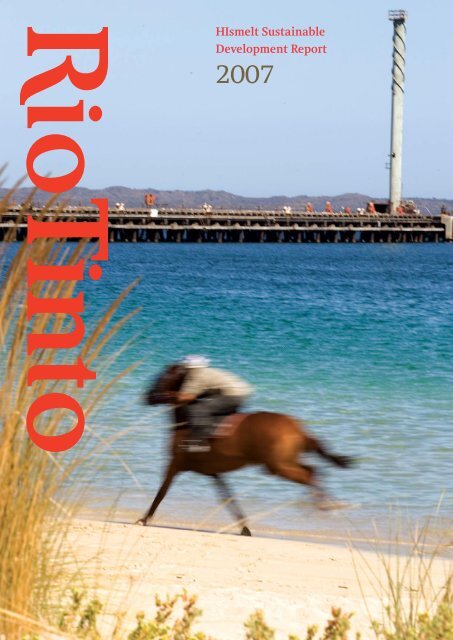
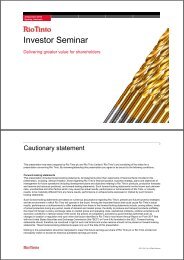


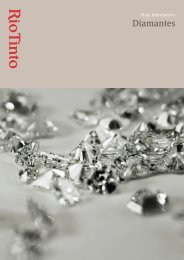

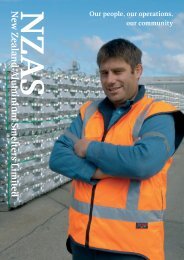
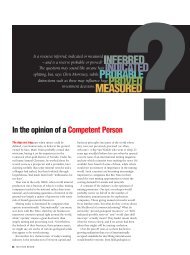
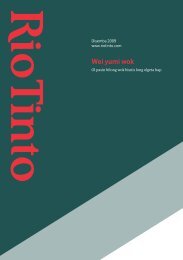
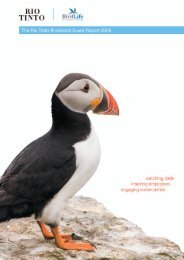
![Download pdf file [PDF: 1.26 MB] - Rio Tinto](https://img.yumpu.com/10319684/1/190x253/download-pdf-file-pdf-126-mb-rio-tinto.jpg?quality=85)

